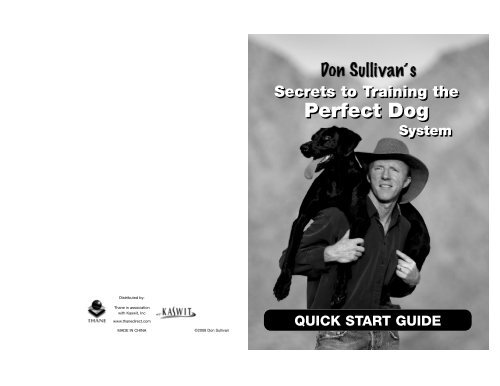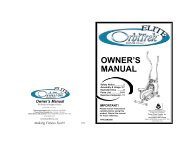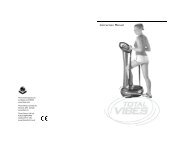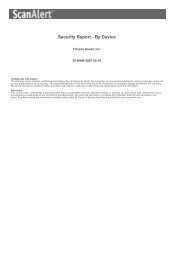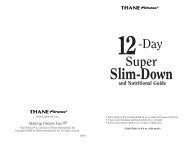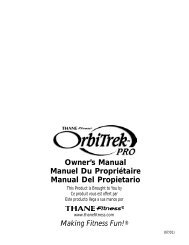The Perfect Dog® Quick Start Guide - Thane
The Perfect Dog® Quick Start Guide - Thane
The Perfect Dog® Quick Start Guide - Thane
You also want an ePaper? Increase the reach of your titles
YUMPU automatically turns print PDFs into web optimized ePapers that Google loves.
Secrets to Training the<br />
<strong>Perfect</strong> Dog<br />
System<br />
Distributed by:<br />
<strong>Thane</strong> in association<br />
with Kaswit, Inc<br />
www.thanedirect.com<br />
MADE IN CHINA<br />
©2008 Don Sullivan<br />
QUICK START GUIDE
Don Sullivan’s “Secrets to Training the <strong>Perfect</strong> Dog” System<br />
<strong>Quick</strong> <strong>Start</strong> <strong>Guide</strong><br />
manner. Your dog will decide at what point your correction level is appropriate for his<br />
individual strength of will and personality. At this point he will obey.<br />
• Every command you teach and every problem you correct will have an impact on all<br />
other areas of your dog’s behavior. You may find that, having just taught or reinforced a<br />
command, a certain unrelated problematic behavior suddenly disappears. This is no<br />
coincidence. It is the direct result of your dog learning to respect you<br />
as his leader.<br />
• Your goal is to control the will of your dog. This simply means that your dog will respond<br />
to any command or instruction you give, regardless of your dog’s desire to respond to<br />
distracting influences. When you have control over the will of your dog, you can reward<br />
him with the precious freedom that he desires and needs to enjoy his life to the fullest.<br />
You will also experience peace of mind knowing that your dog is safe and your life with<br />
him is in order, and you will have joy in your heart knowing that you are truly giving<br />
your dog the best you can offer him.<br />
10
Don Sullivan’s “Secrets to Training the <strong>Perfect</strong> Dog” System<br />
Some Golden Rules<br />
<strong>Quick</strong> <strong>Start</strong> <strong>Guide</strong><br />
Note: Be sure to watch the “Golden Rules” segment, under “Getting <strong>Start</strong>ed,” disc one, for an<br />
in-depth explanation of all the important points to remember.<br />
• Incorporate training into the daily routine with your dog. In the first few days you will<br />
have to set aside short blocks of time to introduce your dog to new concepts, but once<br />
your dog has learned these commands, simply incorporate them into the time you<br />
normally spend with him. For example, instruct your dog to hold a “Down, Stay”<br />
command while you do the dishes or read the newspaper. Watch the segment,<br />
“Incorporate Training into Daily Routine,” under “Getting <strong>Start</strong>ed,” for more ideas.<br />
• It is imperative to leave the Command Collar and one of the Freedom Training Lines<br />
on your dog at all times when in your presence, whether outside or inside the house, until<br />
you reach your overall training goal. At this point you can then begin to “wean” your dog<br />
off the training equipment. Failure to adhere to this important point will undermine your<br />
success.<br />
<strong>The</strong> collar and line allow you to establish consistent control in casual real life situations.<br />
If you make training a separate activity, your dog will pretend to respect you during that<br />
time yet take advantage of opportunities to enforce his own will when he is free of the<br />
training equipment. If you are consistent in leaving the collar and line on at all times,<br />
your dog’s mind will quickly reprogram and he will lose the urge to challenge you as<br />
time progresses.<br />
Safety point: Do not leave the equipment (Command Collar or Freedom Training Lines)<br />
on your dog when you are not around to supervise.<br />
• Do not enforce long, repetitive “drills” with your dog on any command. Once you have<br />
gained a positive response a few times consistently, take a break and play with your dog.<br />
For example, once your dog has performed a “Down” command three times in a row, any<br />
more repetition at that point will only be a source of frustration to your dog; it will not<br />
increase his responsiveness to you.<br />
A dog is an intelligent creature; he does not need hundreds of repetitions on one simple<br />
concept for him to grasp the idea. Once your dog has performed a command, he absolutely<br />
understands what is expected from him. At this point he only needs to develop his<br />
knowledge in terms of how long and in what situations you expect him to follow your<br />
i n s t ruction. Your dog has an amazing memory and he will not forget what he has shown<br />
compliance to. Any non-responsiveness in the future is a function of disrespect, not a lack of<br />
understanding or forgetfulness, as long as your instruction is always clear.<br />
• Whatever concept you are teaching, start your corrections at a moderately soft level and<br />
increase the firmness of your corrections until your dog is responding in the desired<br />
Cautions and Disclaimers<br />
1. Prior to training your dog using Don Sullivan’s Secrets to Training the <strong>Perfect</strong> Dog system;<br />
remember that any dog, no matter the disposition, has the potential to bite. <strong>The</strong> use of Don<br />
Sullivan’s system can expose potential dominant thinking, and hidden aggression that lies<br />
within the dog. For this reason, it is always better to be safe than sorry, so you should closely<br />
follow Don’s advice re g a rding the wearing of protective gloves and the use of muzzles on<br />
any dog that shows signs of stubborn resistance to any command. Growling, barking and<br />
mouthing are all clear signs that the dog could potentially bite and caution must be exerc i s e d .<br />
Even a seemingly easy-going dog could bite once its role of leadership is challenged. Do not<br />
be caught off - g u a rd and unaware .<br />
2. Whenever children are present, always exercise extreme caution to prevent children from<br />
being bitten by any dog. Any dog that is being resistant to training should be muzzled<br />
when around children until such time as the dog is showing consistent, humble<br />
responsiveness to your commands.<br />
3. Any dog, regardless of size, that has clearly shown aggression towards people or dogs in<br />
the past, should not be allowed to roam freely without a muzzle around adults, children or<br />
other dogs until such time as the dog is showing consistent humble responsiveness to your<br />
commands and has shown a consistent change in behavior for a at least a month during<br />
constant training.<br />
4. A dog that has shown aggression only towards dogs, DOES have the potential to bite humans<br />
if challenged for leadership. <strong>The</strong> same is true in the reverse. A dog that has shown<br />
a g g ression only towards people, could potentially become aggressive toward another dog.<br />
5. Any positive change in behavior gained by following Don’s Sullivan’s Secrets to Training<br />
the <strong>Perfect</strong> Dog can be undone if you return to permissive, spoiling attitudes and actions<br />
t o w a rd your dog in the future. All dogs are very intelligent and they will take advantage of<br />
anyone that comes across as a follower rather than a leader. Even a well trained dog can<br />
assess a person in minutes and become disrespectful toward them if they are not<br />
communicating with the dog in a leadership manner. Once leadership has been established<br />
it is not a difficult thing to maintain a great relationship with your dog where YOU are in<br />
c o n t rol but you must be mindful not to return to your old patterns of behavior that cause<br />
your dog to lose respect for you.<br />
6. You may not be able to achieve the success that you desire when working with certain dogs<br />
that have been bred or trained to be aggressive and are exhibiting extreme aggressive behavior.<br />
7. T h e re is always a potential risk involved when training a dog. Dogs are living cre a t u res, and<br />
as such can do unexpected things that can cause either harm to themselves or to other dogs<br />
or people. You must use common sense when dealing with your dog, assessing your own<br />
situation, always leaning towards safety.<br />
9<br />
2
Don Sullivan’s “Secrets to Training the <strong>Perfect</strong> Dog” System<br />
<strong>Quick</strong> <strong>Start</strong> <strong>Guide</strong><br />
Don Sullivan’s “Secrets to Training the <strong>Perfect</strong> Dog” System<br />
<strong>Quick</strong> <strong>Start</strong> <strong>Guide</strong><br />
8. When applying physical correction to any dog there is always the potential to harm a dog.<br />
You must watch the DVDs closely and apply only a sufficient amount of correction to get<br />
your dog to comply with your request. Always start softly with any correction and<br />
increase the firmness until your dog begins to respond consistently. Your dog could have a<br />
predisposed health issue that you are unaware of that could be exacerbated by training.<br />
Consult your veterinarian if you are unsure of your dog’s health condition prior to training.<br />
9. Do not attempt to work with your dog off-leash until you are receiving a consistent<br />
response from your dog on leash, under intense distraction. When attempting any of the<br />
off-leash progressive work, you personally assume all risk and liability associated with<br />
any circumstances that could arise from doing so. Unforeseen and undesirable things can<br />
happen, but you have to be the judge of your surroundings and situation.<br />
10. <strong>Thane</strong> International, Inc., Kaswit Inc., and Don Sullivan are not liable for any harm or<br />
damage caused to or by your dog in relation to the application of any techniques or<br />
suggestions implied or shown in the Don Sullivan’s Secrets to Training the <strong>Perfect</strong> Dog<br />
DVDs, or by the use of the Command Collar (Pat. Pending), Freedom Training Lines,<br />
Fun Fetch Ball, or any other training tools or products recommended by Don Sullivan in<br />
either the Don Sullivan’s Secrets to Training the <strong>Perfect</strong> Dog DVDs or by any other form of<br />
communication.<br />
After having said all that, in summary, basically be careful and enjoy seeing the change in<br />
your dog’s behavior!<br />
Establish yourself as the leader<br />
When clear leadership is given, every dog will respond immediately, but it is natural for<br />
a dog to then test the consistency of that leadership, especially if the person that they are<br />
dealing with has an established history of being subordinate to the dog. Be prepared to<br />
provide consistency to maintain the changes experienced until these changes become firmly<br />
implanted in the behavioral patterns of your dog.<br />
Although many people have heard it said, “Consistency is the key to a well trained dog,” this<br />
in fact is only half the answer. <strong>The</strong> other half of the equation is an appropriate level of corre c t i o n<br />
for the individual strength of will and personality of your dog. If you correct your dog at a<br />
level lower than necessary for his character (i.e. at a level lower than your dog respects), you<br />
will only consistently re i n f o rce in his mind that you are subordinate to him; not his leader.<br />
Never use treats!<br />
NEVER use food/treat re w a rds for any of my training techniques. I also recommend no food to<br />
be given to your dog from any human hand, at any time. It is not necessary to use food bribery in<br />
connection with any commands given and, in fact, handing your dog food is detrimental to the<br />
training process, as explained in the “ Training & Tre a t s ” segment, under “Getting <strong>Start</strong>ed,” disc one.<br />
Mutual respect & affection<br />
Many people find the “no treats rule” hard to adjust to when they have already established<br />
this habit with their dog. However, by immediately ceasing to give any food/treat rewards<br />
once you have begun training using my System, you will help to convey the message to your<br />
dog that “things are changing.” Rest assured that your dog’s love for you will not diminish<br />
in any way because you are no longer buying his attention with treats. Though he may try to<br />
badger you with emotional blackmail for a week or so, he will eventually realize that his<br />
relationship with you is now based on respect and mutual affection rather than food.<br />
3<br />
8
Don Sullivan’s “Secrets to Training the <strong>Perfect</strong> Dog” System<br />
<strong>Quick</strong> <strong>Start</strong> <strong>Guide</strong><br />
Don Sullivan’s “Secrets to Training the <strong>Perfect</strong> Dog” System<br />
<strong>Quick</strong> <strong>Start</strong> <strong>Guide</strong><br />
7<br />
Overview<br />
See changes in just minutes!<br />
You should be able to see a positive change in your dog, within minutes, when you begin to<br />
apply my training techniques properly. In a sense, you will learn a new “language.” In order<br />
to maximize results in the quickest time possible, you need to be wholeheartedly willing to<br />
change the way you communicate with your dog, including ceasing all unproductive or<br />
detrimental communications and actions which could undermine the transformation process.<br />
Why off-leash training is so important<br />
My System is well capable of empowering you to achieve complete off-leash control of<br />
your dog, yet I recognize that not every dog owner’s goal is going to be the same, given<br />
differences in lifestyle, personal preference and physical abilities. Ultimately, I hope to see<br />
every dog earn the precious off-leash freedom which my dogs enjoy, but everyone must<br />
assess their own abilities before developing their goal. For example, if you are somewhat<br />
limited in your physical abilities, you will at the very minimum gain a calmer, more<br />
attentive, less problematic dog by applying some of the most basic elements of my program.<br />
Although I encourage off-leash freedom as the ultimate goal and reward for any dog,<br />
the fact is that leash laws do exist. However, even though you may be required to have your<br />
dog leashed in certain public environments, this in no way diminishes the importance of<br />
training your dog to be trustworthy off a leash, especially when there are lots of distractions.<br />
This “Trust Zone” will not only ensure the safety of your dog whenever there is an<br />
opportunity to give him freedom and proper exercise, it will also let you rest in confidence<br />
knowing that your dog will not cause any disruption or destruction.<br />
Due to previous unsettling experiences, there are many dog owners who would never<br />
even think to allow their dog to be off a leash, unless in a very controlled environment.<br />
However, the reality of life is that circumstances are bound to arise beyond a dog owner’s<br />
direct control, such as a door or gate accidentally left open. Even these especially cautious<br />
dog owners need to recognize the value of the “Trust Zone” for the sake of their dogs’ lives<br />
and their own peace of mind. <strong>The</strong>se owners also need to recognize the value of sufficient<br />
off-leash exercise for the health and emotional well-being of their dogs.<br />
<strong>The</strong> first week<br />
During the first week of using my System, your dog might, in some ways, attempt to re g a i n<br />
the control that he was accustomed to having. He may even develop some new and intere s t i n g<br />
behaviors to try to circumvent your attempts to become his respected leader. This is a normal<br />
part of the re-training process, but as long as you continue to move forward and do not<br />
succumb to his will, you will see that your dog is more compliant by about week two.<br />
A message from “<strong>The</strong> DogFather”<br />
Congratulations on your purchase of Don Sullivan’s “Secrets to<br />
Training the <strong>Perfect</strong> Dog” System. Today is the day that you can begin<br />
to see an amazing transformation in the relationship with your dog.<br />
In order to ensure the maximum and quickest results using my System, there are some key<br />
points to follow, listed in my <strong>Quick</strong> <strong>Start</strong> <strong>Guide</strong>. This <strong>Guide</strong> is a must read before watching<br />
the DVDs and before attempting any training with your dog.<br />
Remember, there is a vast difference between a dog off a leash and a dog that is trained to be<br />
off a leash.<br />
Freedom is the most precious gift that you can give to your dog, over and above love and<br />
affection, yet freedom can be dangerous and problematic unless it is also accompanied by<br />
trust. <strong>The</strong> “Trust Zone” is the point at which an owner can trust his dog to “behave,”<br />
regardless of distractions, without needing to be restrained by a leash or collar. My <strong>Quick</strong><br />
<strong>Start</strong> <strong>Guide</strong> is the road to reaching the “Trust Zone,” quickly.<br />
As soon as you begin training towards the “Trust Zone,” you will begin to witness dramatic<br />
changes in your dog. This is particularly exciting if your main goal of using my System is to<br />
simply solve a few errant behavioral problems.<br />
Now you no longer need to dream of having the best relationship possible with your canine<br />
companion. With my System, and my <strong>Quick</strong> <strong>Start</strong> <strong>Guide</strong> to start you on your way, you will<br />
quickly unleash the true potential that lies within your dog.<br />
I look forward to hearing of your success, just as I have with countless other dog owners<br />
around the world.<br />
Sincerely,<br />
Don Sullivan<br />
“<strong>The</strong> DogFather”<br />
Host, “Doggin’it” TV Show<br />
Former Trainer at Sealand<br />
Guest TV & Radio expert<br />
4
Don Sullivan’s “Secrets to Training the <strong>Perfect</strong> Dog” System<br />
<strong>Quick</strong> <strong>Start</strong> <strong>Guide</strong><br />
Don Sullivan’s “Secrets to Training the <strong>Perfect</strong> Dog” System<br />
<strong>Quick</strong> <strong>Start</strong> <strong>Guide</strong><br />
BEFORE BEGINNING ANY TRAINING WITH YOUR DOG, it is important that<br />
you read all of the <strong>Quick</strong> <strong>Start</strong> <strong>Guide</strong>, as well as watch at least the following introductory<br />
segments on disc one of the DVD set. After watching and applying the instruction within<br />
these segments, you can then begin to focus on other segments as needed.<br />
5<br />
Important introductory segments<br />
Getting <strong>Start</strong>ed: Training Philosophy, Golden Rules, Training & Treats, Incorporate Training into Daily Routine<br />
Equipment: All segments<br />
Commands: Pulling on the Leash, Down Command<br />
Exercise: Retrieving<br />
I highly recommend watching both DVDs in their entirety. Congratulations, you are on your<br />
way to having the dog of your dreams!<br />
DISC 1<br />
Getting <strong>Start</strong>ed<br />
Training Philosophy 7:54<br />
Golden Rules 6:29<br />
Training & Treats 3:16<br />
Children & Training 0:49<br />
Verbal Baiting 2:41<br />
Incorporate Training into Daily Routine 3:20<br />
Trust Zone 1:17<br />
Housebreaking 14:25<br />
Equipment<br />
Essential Equipment 3:29<br />
Specialized Equipment 6:45<br />
Command Collar 3:33<br />
Electronic Collar 3:44<br />
Prong Collar 4:53<br />
Useless Equipment 3:37<br />
Retractable Leash 1:21<br />
Commands<br />
Pulling on the Leash 13:13<br />
Sit Command 5:27<br />
Down Command 6:50<br />
Stay Command 4:21<br />
Down from a Distance 4:36<br />
Hidden Stay Command 1:49<br />
Come Command 7:21<br />
Heel Command 7:02<br />
Moving Off-Leash 8:08<br />
Exercise<br />
Retrieving 11:43<br />
Playing 1:06<br />
Off-Leash Control 4:17<br />
Dog Parks 6:20<br />
Swimming 2:48<br />
Fun Fetch Ball 2:53<br />
Socializing 1:54<br />
DISC 2<br />
Problem Behaviors<br />
Problem Behaviors Introduction 2:21<br />
Barking 6:17<br />
Begging 6:29<br />
Bolting 4:48<br />
Chasing cars/bikes/etc. 2:44<br />
Chasing & Nipping People 3:17<br />
Chewing Hands/Nipping 3:04<br />
Chewing 3:57<br />
Chewing on the Leash 1:02<br />
Clipping Nails 3:08<br />
Problem Behaviors (more)<br />
Counter Surfing 2:09<br />
Crazy in Car & Relax Command 2:46<br />
Crazy in Crate 3:37<br />
Desensitization 3:40<br />
Digging 3:00<br />
Getting into Garbage 1:12<br />
Jealousy 2:36<br />
Jumping Up 8:18<br />
Licking 2:00<br />
Licking – Small Dogs 1:38<br />
Separation Anxiety 3:08<br />
Aggression<br />
Aggression 7:25<br />
Aggression Towards People 9:07<br />
Aggression – Small Dogs 2:51<br />
Fear Aggression 3:47<br />
Aggressive Over Food 5:21<br />
Thoughts on Guard Dogs 5:32<br />
Sharing Bones 1:14<br />
Perimeters & Boundaries<br />
Bolting out the Door 7:34<br />
Answering the Door 3:44<br />
Staying off the Road 5:14<br />
Baby Gates 3:45<br />
Freedom in the House 3:52<br />
Camping Boundaries 2:28<br />
Boundary Line Caution 2:50<br />
Miscellaneous<br />
Getting in the Car 1:14<br />
Safe Driving 3:08<br />
Safe Boating 1:56<br />
Safe Hiking 2:45<br />
Neutering 2:00<br />
Tricks & Fun Things 4:28<br />
Critical Steps to Follow<br />
1. Watch through the segments, “ Training Philosophy,” “Golden Rules,” and “ Treats & Tr a i n i n g , ”<br />
under “Getting <strong>Start</strong>ed,” disc one, before starting any training with your dog.<br />
2. Watch all of the segments under “ E q u i p m e n t , ” disc one. Here you will learn how to apply<br />
the Command Collar and adjust the size to custom fit your dog; you will also learn how<br />
to use the Freedom Training Lines.<br />
3. Watch the segment, “Pulling on the Leash,” under “ C o m m a n d s , ” disc one, which will help you<br />
teach your dog to never pull on the leash. Correcting leash pulling is an imperative step in<br />
the process of gaining your dog’s respect. You must maintain a zero tolerance for pulling on<br />
the leash. You cannot make excuses for your dog’s pulling such as, “He seems unable to<br />
c o n t rol himself when he’s distracted.” If my technique is followed properly it should only<br />
take a few minutes to get your dog to stop leash pulling, fore v e r.<br />
<strong>The</strong> purpose of this exercise has nothing to do with getting your dog to walk tightly beside<br />
you at a “heel” position, but rather to teach your dog to respect the boundaries of a loose<br />
leash. <strong>The</strong> “Pulling on the Leash” e x e rcise is the building block and beginning stage of solid<br />
o ff-leash contro l .<br />
4. Watch the “Down Command” segment, under “ C o m m a n d s , ” disc one. As mentioned in this<br />
section, your initial goal is to get your dog to perform three “Down” commands in a ro w,<br />
without needing any correction. After this, you can start adding distractions at increasing<br />
levels, such as throwing a ball on the ground or having a small child run by. Ultimately, you<br />
want your dog to respond to a “Down” command the first time, every time, wherever you issue<br />
the command, and to hold the command until you release him, however long that might be.<br />
5. Begin any new training exercise relating to your dog’s most prominent issues.<br />
6. A very useful segment to focus on early in the training process is, “ R e t r i e v i n g , ” under “ E x e rc i s e , ”<br />
disc one. Sufficient intense exercise on a daily basis is critical to keep your dog from releasing<br />
his energy in undesirable ways. It is vital for his health and emotional well-being. Apart from<br />
retrieving, there are other options for intense cardiovascular activity such as bike riding with<br />
your dog, and swimming. Exercising your dog does not have to take a lot of time. Most dogs<br />
can be satisfied with two 20 minute sessions of continuous vigorous exercise each day.<br />
When you can trust your dog to retrieve for you every time, you can then easily, eff i c i e n t l y,<br />
and joyfully satisfy one of his most important needs. Retrieving also acts as useful play time,<br />
and a positive fun re w a rd, in between training periods, whether inside or outside the house.<br />
My Fun Fetch Ball is the perfect tool for teaching your dog to retrieve. (Watch the “Fun Fetch<br />
B a l l ” segment, under “ E x e rc i s e , ” disc one).<br />
7. If you have more than one dog, you will need one Extra Equipment Set (Command Collar and<br />
Set of Freedom Training Lines) for each of your dogs. You can order by filling in the order form<br />
or logging on to www. t h a n e d i re c t . c o m .<br />
6


